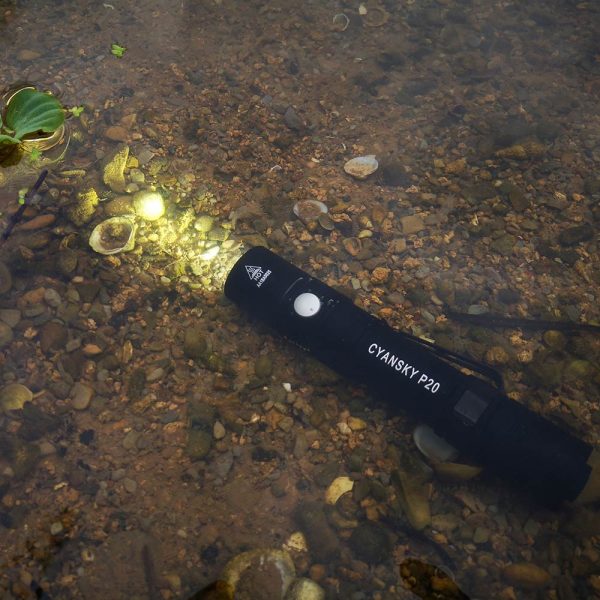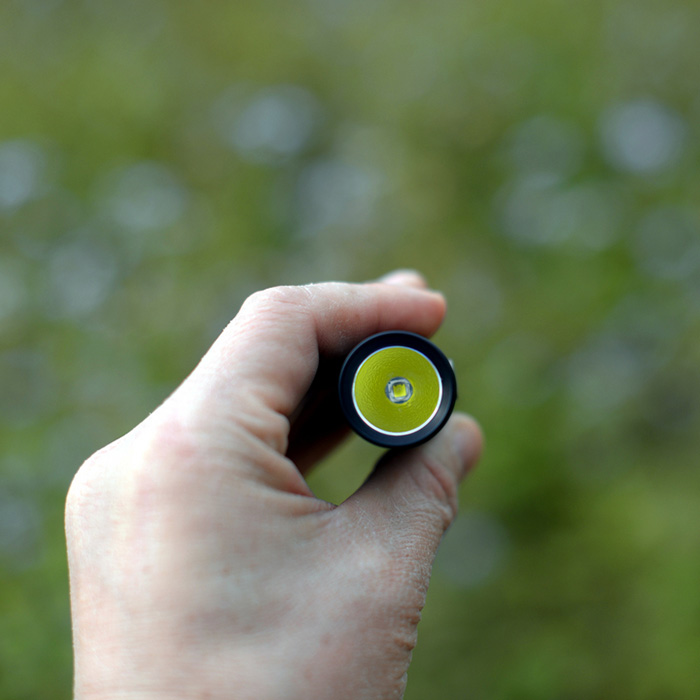How to Make Sure Your Flashlight Is Safe for Use in Hazardous Areas

Using the right flashlight in hazardous areas is critical for your safety. Non-compliant flashlights can lead to devastating consequences, such as fire hazards or explosions, especially in environments with flammable gases or dust. Poor insulation or substandard materials in uncertified flashlights increase the risk of electrical failures. These issues not only endanger lives but also result in legal and financial penalties for businesses.
To ensure your flashlight is safe, look for certifications like UL 913, ATEX, or IECEx. These certifications guarantee compliance with industry standards, reducing risks in explosive atmospheres. Matching the flashlight to your specific environment is equally important. A safe flashlight can protect you and prevent accidents in high-risk areas.
Key Takeaways
Always pick flashlights with safety labels like UL, ATEX, or IECEx. These show they meet safety rules for dangerous places.
Use flashlights made to be safe by limiting heat and sparks. This helps stop fires from starting near flammable stuff.
Check your flashlight often. Look for damage, clean it, and change batteries when needed to keep it safe.
Learn about the dangers in your area. Choose a flashlight that matches these dangers to stay safe and follow rules.
Ask experts if you’re unsure which flashlight to use. They can help you find safe and good tools.
Understanding Hazardous Areas
Defining Hazardous Areas
Hazardous areas are environments where the presence of flammable gases, combustible dusts, or ignitable fibers creates a significant risk of fire or explosion. These areas require special precautions to ensure safety. You might encounter such locations in industries like oil and gas, chemical production, or grain processing. Using the wrong equipment, such as a non-compliant flashlight, can ignite these materials, leading to catastrophic consequences. Understanding the classifications of hazardous locations helps you choose the right tools and minimize risks.
Classes, Divisions, and Groups
Hazardous areas are categorized into classes, divisions, and groups based on the type of material present and the likelihood of an explosive atmosphere forming.
Class I, II, and III
Class | Description | Examples of Locations |
|---|---|---|
Class I | Flammable gases, vapors, or liquids | Oil refineries, offshore oil rigs |
Class II | Combustible dusts | Coal mines, grain silos |
Class III | Ignitable fibers or flyings | Paper mills, woodworking facilities |
Class I locations involve flammable gases or vapors, which are common in oil and gas facilities. Class II locations deal with combustible dusts, such as those found in grain silos or coal mines. Class III locations contain ignitable fibers, often present in textile or woodworking industries.
Divisions 1 and 2
Division | Description |
|---|---|
Division 1 | High probability of explosive mixtures due to continuous or frequent presence. |
Division 2 | Low probability of explosive mixtures, occurring only under abnormal conditions. |
Division 1 areas have a constant or frequent presence of hazardous materials, while Division 2 areas only pose a risk during equipment malfunctions or leaks.
Groups A to G
Groups further classify hazardous materials based on their properties. For gases (Class I), Groups A to D cover materials like acetylene and propane. For dusts and fibers (Class II and III), Groups E to G include materials like metal dust and grain dust.
Examples of Hazardous Environments
You can find hazardous locations in various industries. Here are some examples:
Industrial Facilities: Chemical plants and manufacturing units often handle volatile substances.
Oil and Gas Sites: Refineries and offshore rigs contain flammable gases and vapors.
Grain Processing Plants: Grain silos and flour mills produce combustible dusts that can ignite easily.
Tip: Always assess the environment before using any equipment to ensure it meets safety standards for hazardous areas.
Key Features of a Safe Flashlight

Intrinsically Safe Flashlights
Definition and Importance
An intrinsically safe flashlight is specifically designed to operate in hazardous environments without causing a fire or explosion. These flashlights limit electrical and thermal energy emissions, ensuring they cannot ignite flammable gases, vapors, or dust. This feature is critical in industries like oil and gas, mining, and chemical production, where volatile materials are common. Using a non-intrinsically safe flashlight in such areas increases the risk of ignition, which can lead to catastrophic accidents. By choosing an intrinsically safe flashlight, you reduce this risk and enhance workplace safety.
Tip: Always verify that your flashlight is labeled as "intrinsically safe" and meets the required safety ratings for your environment.
Safety Certifications
UL, ATEX, and IECEx
Safety certifications ensure that a flashlight complies with strict safety guidelines for hazardous areas. UL certification focuses on North American standards, emphasizing explosion-proof designs. ATEX applies to the European Union, requiring rigorous risk assessments for equipment in explosive atmospheres. IECEx provides a global framework, making it essential for international use.
Certification | Description | Regional Applicability |
|---|---|---|
ATEX | EU-specific standards for equipment in explosive atmospheres | European Union |
IECEx | Global certification for equipment in explosive atmospheres | International |
UL | North American safety standards for electronic products | North America |
IP Ratings for Resistance
IP ratings measure a flashlight's resistance to dust and water. The first digit indicates protection against solids, while the second digit measures resistance to liquids. For example, a flashlight with an IP68 rating is completely dust-tight and can withstand continuous immersion in water. This specificity helps you choose a flashlight that can endure harsh environmental conditions.
Rating | Protection Level | Description |
|---|---|---|
IPX4 | Moderate | Can withstand splashing water for 10 minutes. |
IPX6 | High | Resists high-pressure water jets from any direction. |
IPX8 | Maximum | Suitable for continuous immersion in water. |
Essential Design Features
Ignition Temperature
A flashlight's ignition temperature determines how much heat it can generate before igniting surrounding materials. In hazardous areas, you need a flashlight with a low ignition temperature to prevent accidental fires or explosions. Always check the safety ratings to ensure compliance with your environment's requirements.
Non-Sparking Materials
Safe flashlights use non-sparking materials like aluminum or plastic to prevent sparks during operation. This feature is crucial in environments with flammable gases or dust, where even a small spark can cause a disaster.
Battery Safety
Battery safety is another critical factor. Intrinsically safe flashlights use energy-limiting circuits to prevent overheating or short circuits. These features ensure that the flashlight remains safe even under extreme conditions.
Note: Regularly inspect your flashlight's battery for signs of wear or damage to maintain its safety.
Choosing the Right Flashlight

Assessing Your Environment
Identifying Hazard Classifications
Understanding the classification of your hazardous location is the first step in selecting the right flashlight. The National Electric Code (NEC) categorizes hazardous locations into three classes:
Class I: Areas with flammable gases, vapors, or liquids, such as oil refineries.
Class II: Locations with combustible dusts, like grain silos.
Class III: Environments with ignitable fibers, such as paper mills.
Each class is further divided into Division 1 and Division 2. Division 1 indicates a constant presence of ignitable materials, while Division 2 suggests these materials are present only under abnormal conditions. Matching your flashlight to these classifications reduces the explosion risk and ensures compliance with safety requirements.
Evaluating Environmental Conditions
Environmental factors like temperature, humidity, and dust levels can affect flashlight performance. Flashlights designed for hazardous locations undergo rigorous testing in controlled environments, such as:
Waterproof testing areas to simulate rain or immersion.
Dust chambers to evaluate performance in sandy or dusty conditions.
Temperature-controlled rooms to test reliability in extreme heat or cold.
You should also consider battery safety. Mishandling lithium-ion batteries or using incompatible ones can lead to overheating or even a fire. Always store spare batteries away from heat, cold, or liquids to avoid safety hazards.
Matching Flashlight Specifications
Certification Requirements
Flashlights for hazardous locations must meet specific safety standards. Look for certifications like UL, ATEX, or IECEx to ensure compliance. These certifications confirm that the flashlight is safe for use in environments with flammable materials. Additionally, check the maximum surface temperature rating to ensure the flashlight won’t ignite surrounding substances.
Light Output and Beam Type
The light output and beam type should match your work environment. For example, wide beams work well in confined spaces, while focused beams are better for long-distance visibility. Flashlights are also temperature-rated from T1 to T6, with T6 being the safest for areas with low ignition temperatures. Selecting the right beam type and temperature rating minimizes the risk of accidents.
Practical Selection Tips
Researching Brands
Not all flashlights are created equal. Research reputable brands that specialize in hazardous location equipment. Look for customer reviews and industry recommendations to ensure quality and reliability.
Reading Product Labels
Product labels provide critical information about certifications, maximum surface temperature, and safety requirements. Always verify these details before purchasing a flashlight.
Consulting Experts
If you’re unsure about the right flashlight for your hazardous location, consult an expert. Professionals can help you assess your environment and recommend models that meet your specific needs.
Tip: Never compromise on safety. A well-researched flashlight can save lives and prevent costly accidents.
Maintaining Flashlight Safety
Regular Maintenance
Cleaning and Inspection
Regular cleaning and inspection are essential to keep your flashlight safe for use in hazardous environments. Before and after each use, inspect the flashlight for cracks, leaks, or other damage. Pay close attention to the seals and casing, as weak seals can allow water or dust to enter, compromising safety. Use a soft cloth and mild detergent to clean the flashlight. Avoid abrasive cleaners that could damage the surface or reduce its durability. Keep the battery compartment free of debris to prevent overheating or electrical issues. Proper cleaning ensures the flashlight remains reliable and reduces the risk of accidents caused by hazardous materials.
Tip: Store your flashlight in a cool, dry place away from direct sunlight or heat sources to extend its lifespan.
Safe Battery Replacement
Battery maintenance plays a critical role in flashlight safety. Replace batteries as needed and ensure they are compatible with the flashlight's specifications. Mishandling batteries can lead to overheating or even explosions, especially in environments with hazardous materials. Always follow the manufacturer's guidelines for battery replacement. If you notice any signs of corrosion or leakage, replace the batteries immediately. Proper battery care minimizes the risk of malfunctions and ensures the flashlight operates safely in hazardous conditions.
When to Replace Your Flashlight
Signs of Wear
Over time, flashlights can show signs of wear that compromise their safety. Look for cracks, fading certifications, or weak seals that allow dust or moisture to enter. If the flashlight fails to maintain consistent light output or the battery compartment shows signs of damage, it may no longer be safe for use in hazardous areas. Regular inspections help you identify these issues early and prevent potential risks.
Upgrading for Compliance
Upgrading your flashlight ensures it meets current safety standards and certifications. Familiarize yourself with international standards like ATEX, IECEx, or UL to verify compliance. Flashlights designed for hazardous locations must align with classifications set by the NEC and meet strict quality assurance standards. If your flashlight no longer meets these requirements, replace it with a certified model to maintain safety and reduce the risk of accidents involving hazardous materials.
Note: Always choose flashlights from reputable manufacturers that prioritize quality and compliance with safety standards.
Using a safe flashlight in hazardous areas is essential for protecting lives and preventing accidents. Start by understanding your environment and identifying its hazard classifications. Choose an intrinsically safe flashlight with certifications like ATEX or UL to ensure compliance and reliability. Regular maintenance, such as inspecting for damage and replacing batteries, keeps your flashlight in optimal condition. A case study from the oil and gas industry highlights the dangers of using non-compliant equipment, emphasizing the need for proper selection. Always consult experts to match your flashlight to your specific needs and prioritize safety above all.
FAQ
What makes a flashlight safe for hazardous environments?
A safe flashlight for hazardous environments must have certifications like UL or ATEX. It should use non-sparking materials and limit heat emissions. These features prevent ignitable materials from catching fire, ensuring safety in high-risk areas.
How do I know if my flashlight is intrinsically safe?
Check the product label for certifications like UL 913 or ATEX. These certifications confirm the flashlight meets safety standards for hazardous environments. Intrinsically safe flashlights also limit electrical energy to avoid ignitable sparks.
Can I use any flashlight in a dusty environment?
No, you must use a flashlight designed for hazardous environments. Dusty areas often contain ignitable particles. A certified flashlight with proper IP ratings ensures safety by preventing sparks or overheating.
Why are non-sparking materials important in hazardous areas?
Non-sparking materials reduce the risk of ignitable sparks when the flashlight comes into contact with other surfaces. This feature is critical in environments with flammable gases, dust, or fibers.
How often should I inspect my flashlight for safety?
Inspect your flashlight before and after each use. Look for cracks, weak seals, or battery damage. Regular inspections ensure the flashlight remains safe for hazardous environments and prevents ignitable accidents.
See Also
Key Strategies for Proper Flashlight Care and Maintenance
A Homeowner's Guide to Selecting the Ideal Emergency Flashlight
Guidelines for Picking the Perfect Flashlight for Camping
Our Emergency Flashlight: Designed for Long-Lasting Durability
